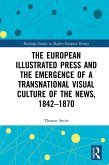German Colonialism, Visual Culture, and Modern Memory (eBook, PDF)
Redaktion: Langbehn, Volker
46,95 €
46,95 €
inkl. MwSt.
Sofort per Download lieferbar

23 °P sammeln
46,95 €
Als Download kaufen

46,95 €
inkl. MwSt.
Sofort per Download lieferbar

23 °P sammeln
Jetzt verschenken
Alle Infos zum eBook verschenken
46,95 €
inkl. MwSt.
Sofort per Download lieferbar
Alle Infos zum eBook verschenken

23 °P sammeln
German Colonialism, Visual Culture, and Modern Memory (eBook, PDF)
Redaktion: Langbehn, Volker
- Format: PDF
- Merkliste
- Auf die Merkliste
- Bewerten Bewerten
- Teilen
- Produkt teilen
- Produkterinnerung
- Produkterinnerung

Bitte loggen Sie sich zunächst in Ihr Kundenkonto ein oder registrieren Sie sich bei
bücher.de, um das eBook-Abo tolino select nutzen zu können.
Hier können Sie sich einloggen
Hier können Sie sich einloggen
Sie sind bereits eingeloggt. Klicken Sie auf 2. tolino select Abo, um fortzufahren.

Bitte loggen Sie sich zunächst in Ihr Kundenkonto ein oder registrieren Sie sich bei bücher.de, um das eBook-Abo tolino select nutzen zu können.
Investigating visual communication and mass culture, print culture and suggestive racial politics, racial aesthetics, racial politics and early German film, racial continuity and German film, and photography, German Colonialism, Visual Culture, and Modern Memory offers compelling evidence of a German society between 1884 and 1919 that produced vibrant and heterogeneous-and at times contradictory-cultures of colonialism.
- Geräte: PC
- mit Kopierschutz
- eBook Hilfe
- Größe: 5.47MB
Andere Kunden interessierten sich auch für
![German Colonialism, Visual Culture, and Modern Memory (eBook, ePUB) German Colonialism, Visual Culture, and Modern Memory (eBook, ePUB)]() German Colonialism, Visual Culture, and Modern Memory (eBook, ePUB)46,95 €
German Colonialism, Visual Culture, and Modern Memory (eBook, ePUB)46,95 €![German Colonialism and National Identity (eBook, PDF) German Colonialism and National Identity (eBook, PDF)]() German Colonialism and National Identity (eBook, PDF)46,95 €
German Colonialism and National Identity (eBook, PDF)46,95 €![The European Illustrated Press and the Emergence of a Transnational Visual Culture of the News, 1842-1870 (eBook, PDF) The European Illustrated Press and the Emergence of a Transnational Visual Culture of the News, 1842-1870 (eBook, PDF)]() Thomas SmitsThe European Illustrated Press and the Emergence of a Transnational Visual Culture of the News, 1842-1870 (eBook, PDF)40,95 €
Thomas SmitsThe European Illustrated Press and the Emergence of a Transnational Visual Culture of the News, 1842-1870 (eBook, PDF)40,95 €![Longman Companion to the Formation of the European Empires, 1488-1920 (eBook, PDF) Longman Companion to the Formation of the European Empires, 1488-1920 (eBook, PDF)]() Muriel E. ChamberlainLongman Companion to the Formation of the European Empires, 1488-1920 (eBook, PDF)34,95 €
Muriel E. ChamberlainLongman Companion to the Formation of the European Empires, 1488-1920 (eBook, PDF)34,95 €![Imperial Germany 1890 - 1918 (eBook, PDF) Imperial Germany 1890 - 1918 (eBook, PDF)]() Ian PorterImperial Germany 1890 - 1918 (eBook, PDF)40,95 €
Ian PorterImperial Germany 1890 - 1918 (eBook, PDF)40,95 €![Decolonization (eBook, PDF) Decolonization (eBook, PDF)]() Raymond BettsDecolonization (eBook, PDF)37,95 €
Raymond BettsDecolonization (eBook, PDF)37,95 €![The Wars of French Decolonization (eBook, PDF) The Wars of French Decolonization (eBook, PDF)]() Anthony ClaytonThe Wars of French Decolonization (eBook, PDF)51,95 €
Anthony ClaytonThe Wars of French Decolonization (eBook, PDF)51,95 €-
-
-
Investigating visual communication and mass culture, print culture and suggestive racial politics, racial aesthetics, racial politics and early German film, racial continuity and German film, and photography, German Colonialism, Visual Culture, and Modern Memory offers compelling evidence of a German society between 1884 and 1919 that produced vibrant and heterogeneous-and at times contradictory-cultures of colonialism.
Dieser Download kann aus rechtlichen Gründen nur mit Rechnungsadresse in A, B, BG, CY, CZ, D, DK, EW, E, FIN, F, GR, HR, H, IRL, I, LT, L, LR, M, NL, PL, P, R, S, SLO, SK ausgeliefert werden.
Produktdetails
- Produktdetails
- Verlag: Taylor & Francis
- Seitenzahl: 328
- Erscheinungstermin: 1. Juli 2010
- Englisch
- ISBN-13: 9781135153359
- Artikelnr.: 42507991
- Verlag: Taylor & Francis
- Seitenzahl: 328
- Erscheinungstermin: 1. Juli 2010
- Englisch
- ISBN-13: 9781135153359
- Artikelnr.: 42507991
Volker Langbehn (Ph.D. University of Minnesota, Minneapolis, 1998) is Associate Professor of German at San Francisco State University, California. He is the author of Arno Schmidt's Zettels Traum: An Analysis (2003) and has published articles on Friedrich Nietzsche, Christa Wolf, Arno Schmidt, Fritz von Unruh, Novalis and Gert Heidenreich, and the visual representation of German Colonialism. He is the co-editor with Dr. Mohammad Salama of Colonial (Dis)-Continuities: Race, Holocaust, and Postwar Germany (2010). His current book project tentatively titled The Visual Representation of Cultural Identity in German Mass Culture Around 1900 focuses on visual representations of Africa in German mass culture. It is a study of how racism can develop in a modern society through subtle, everyday means, and it explores the negative consequences of race thinking upon the long-term development of German identity. He examines how images of Africa and Africans contained in four types of media - political caricatures in satirical magazines, picture postcards, black-and-white photographs, and illustrated children's literature - helped foster a racialized German national identity.
Acknowledgements. Introduction: Picturing Race: Visuality and German
Colonialism. Volker Langbehn. German Colonialism 1884-1919. 1. Advertising
and the Optics of Colonial Power at the fin de siècle. David Ciarlo. 2.
"... will try to send you the best views from here" - Postcards from the
Colonial War in Namibia (1904-1908). Felix Axster. 3. Harmless
"Kolonialbiedermeier"? Colonial and Exotic Trading Cards. Joachim Zeller.
4. Cakewalking the Anarchy of Empire around 1900. Astrid Kusser. 5. Satire
Magazines and Racial Politics. Volker Langbehn. 6. Demystifying Colonial
Settlement: Building Handbooks for Settlers, 1904-1930. Itohan Osayimwese.
7. Patriotism, Spectacle and Reverie: Colonialism in Early Cinema. Wolfgang
Fuhrmann. German Postcolonialism 1919-Present. 8. Persuasive Maps and a
Suggestive Novel - Hans Grimm's Volk ohne Raum and German Cartography in
Southwest Africa. Oliver Simons. 9. Colonial Disgust: The Colonial Master's
Emotion of Superiority. Thomas Schwarz. 10. Weimar Revisions of Germany's
Colonial Past: The Photomontages of Hannah Höch and László Moholy-Nagy.
Brett M. Van Hoesen. 11. The "Colonial Idea" in Weimar Cinema. Christian
Rogowski. 12. "The Black Jew": An After-Image of German Colonialism. Birgit
Haehnel. 13. Reenacting Colonialism: Germany and its Former Colonies in
Recent TV Productions. Wolfgang Struck. 14. Postcolonial Amnesia? Taboo
Memories and Kanaks with Cameras. Deniz Göktürk. Contributors. References.
Index.
Colonialism. Volker Langbehn. German Colonialism 1884-1919. 1. Advertising
and the Optics of Colonial Power at the fin de siècle. David Ciarlo. 2.
"... will try to send you the best views from here" - Postcards from the
Colonial War in Namibia (1904-1908). Felix Axster. 3. Harmless
"Kolonialbiedermeier"? Colonial and Exotic Trading Cards. Joachim Zeller.
4. Cakewalking the Anarchy of Empire around 1900. Astrid Kusser. 5. Satire
Magazines and Racial Politics. Volker Langbehn. 6. Demystifying Colonial
Settlement: Building Handbooks for Settlers, 1904-1930. Itohan Osayimwese.
7. Patriotism, Spectacle and Reverie: Colonialism in Early Cinema. Wolfgang
Fuhrmann. German Postcolonialism 1919-Present. 8. Persuasive Maps and a
Suggestive Novel - Hans Grimm's Volk ohne Raum and German Cartography in
Southwest Africa. Oliver Simons. 9. Colonial Disgust: The Colonial Master's
Emotion of Superiority. Thomas Schwarz. 10. Weimar Revisions of Germany's
Colonial Past: The Photomontages of Hannah Höch and László Moholy-Nagy.
Brett M. Van Hoesen. 11. The "Colonial Idea" in Weimar Cinema. Christian
Rogowski. 12. "The Black Jew": An After-Image of German Colonialism. Birgit
Haehnel. 13. Reenacting Colonialism: Germany and its Former Colonies in
Recent TV Productions. Wolfgang Struck. 14. Postcolonial Amnesia? Taboo
Memories and Kanaks with Cameras. Deniz Göktürk. Contributors. References.
Index.
Acknowledgements. Introduction: Picturing Race: Visuality and German
Colonialism. Volker Langbehn. German Colonialism 1884-1919. 1. Advertising
and the Optics of Colonial Power at the fin de siècle. David Ciarlo. 2.
"... will try to send you the best views from here" - Postcards from the
Colonial War in Namibia (1904-1908). Felix Axster. 3. Harmless
"Kolonialbiedermeier"? Colonial and Exotic Trading Cards. Joachim Zeller.
4. Cakewalking the Anarchy of Empire around 1900. Astrid Kusser. 5. Satire
Magazines and Racial Politics. Volker Langbehn. 6. Demystifying Colonial
Settlement: Building Handbooks for Settlers, 1904-1930. Itohan Osayimwese.
7. Patriotism, Spectacle and Reverie: Colonialism in Early Cinema. Wolfgang
Fuhrmann. German Postcolonialism 1919-Present. 8. Persuasive Maps and a
Suggestive Novel - Hans Grimm's Volk ohne Raum and German Cartography in
Southwest Africa. Oliver Simons. 9. Colonial Disgust: The Colonial Master's
Emotion of Superiority. Thomas Schwarz. 10. Weimar Revisions of Germany's
Colonial Past: The Photomontages of Hannah Höch and László Moholy-Nagy.
Brett M. Van Hoesen. 11. The "Colonial Idea" in Weimar Cinema. Christian
Rogowski. 12. "The Black Jew": An After-Image of German Colonialism. Birgit
Haehnel. 13. Reenacting Colonialism: Germany and its Former Colonies in
Recent TV Productions. Wolfgang Struck. 14. Postcolonial Amnesia? Taboo
Memories and Kanaks with Cameras. Deniz Göktürk. Contributors. References.
Index.
Colonialism. Volker Langbehn. German Colonialism 1884-1919. 1. Advertising
and the Optics of Colonial Power at the fin de siècle. David Ciarlo. 2.
"... will try to send you the best views from here" - Postcards from the
Colonial War in Namibia (1904-1908). Felix Axster. 3. Harmless
"Kolonialbiedermeier"? Colonial and Exotic Trading Cards. Joachim Zeller.
4. Cakewalking the Anarchy of Empire around 1900. Astrid Kusser. 5. Satire
Magazines and Racial Politics. Volker Langbehn. 6. Demystifying Colonial
Settlement: Building Handbooks for Settlers, 1904-1930. Itohan Osayimwese.
7. Patriotism, Spectacle and Reverie: Colonialism in Early Cinema. Wolfgang
Fuhrmann. German Postcolonialism 1919-Present. 8. Persuasive Maps and a
Suggestive Novel - Hans Grimm's Volk ohne Raum and German Cartography in
Southwest Africa. Oliver Simons. 9. Colonial Disgust: The Colonial Master's
Emotion of Superiority. Thomas Schwarz. 10. Weimar Revisions of Germany's
Colonial Past: The Photomontages of Hannah Höch and László Moholy-Nagy.
Brett M. Van Hoesen. 11. The "Colonial Idea" in Weimar Cinema. Christian
Rogowski. 12. "The Black Jew": An After-Image of German Colonialism. Birgit
Haehnel. 13. Reenacting Colonialism: Germany and its Former Colonies in
Recent TV Productions. Wolfgang Struck. 14. Postcolonial Amnesia? Taboo
Memories and Kanaks with Cameras. Deniz Göktürk. Contributors. References.
Index.







